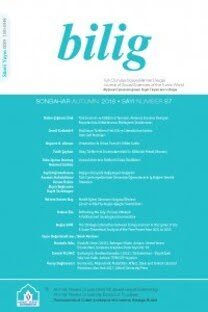How Did the State and Kinship Create Soviet Economy? (Case of Kyrgyzstan)
Sovyetler Birliği 1930'lu yıllarda kurulmuş olsa da kuruluşu takip eden geçiş dönemi, kolhozlaştırma, büyük Sovyet kıtlığı ve İkinci Dünya Savaşı olarak bilinen büyük süreçler ve bu süreçlerin getirdiği olumsuz neticelerinden dolayı 1950'li yılların sonuna kadar uzamıştır. Ülke zayıf ve ekonomi ve sosyal sıkıntılarla dolu olsa da, rejim ülke içindeki toplulukların yerel geleneklerini ortadan kaldırarak yeni sistem kuracağını ve yeni Sovyet kuşağını yaratacağını propaganda ediyordu. Söz konusu döneme odaklaşan bu makale şu hipotezi ileri sürür: Görünürde akrabalık bağlar, inançlar ve âdetler gibi yerel geleneklere karşı mücadele veren ve modern bir devlet kurmayı propaganda eden Sovyetler Birliği perde arkasında yerel geleneklerle işbirliği yaparak durumunu düzeltebilmiştir. Sovyet Birliğinin bir uç köşesini oluşturan Kırgızistanda, daha net olarak bir köyde yapılan sözlü tarih çalışmalarından elde edilen taze veriler, devlet ile yerli geleneklerin işbirliği sonucunda kırsal kesim Sovyet ekonomisini kalkındığını gösteriyor.
Devlet ile Akrabalık İlişkiler Ağı Sovyet Ekonomisini Nasıl Kurdular? (Kırgızistan Örneği)
The Soviet Union was established in about 1920, but due to large-scale processes such as collectivization, World War II, and their negative consequences, the transitional period that followed the establishment was extended to the late 1950s. Rapid Soviet modernization through the liquidation of local traditions was in many places just a show. This essay focusing on local practices argues that the Soviet economy in rural Kyrgyz Republic was created through the interaction between the state and local kinship relations. Moreover, where the Soviet class system was weak in rural areas in particular, kinship relations worked instead. Based mainly on freshly obtained empiric materials from a village in Kyrgyzstan, this article displays the mechanism of how the kinship and the state created an economy in the context of the Soviet rural areas.
___
- Abramzon, Saul, Klavdia Antipina, Galina, Vasileva, E. I. Makhova and D. Sulaimanov (1958). Byt Kolkhoznikov Kirgizskikh Selenii Darkhan i Chichkan: Kolkhoz Imeni K. E. Voroshilova ("Ala-too") Pokrovskogo Raiona Issyk-Kul'skoi Oblasti i Chichkan. Moscow: Akademia Nauk SSSR.
- ________, (1971). Kirgizy i ih Etnogeneticheskiye i Istoriko-kultirniye Svyazi. Leningrad: Nauka.
- Aytbayev, Mukash (1957). Istoriko - Kulturnyye Svyazi Kirgizskogo i Russkogo Narodov ( po Materialam Issyk - Kulskoy Oblasti Kirgizskoy SSR ). Frunze: Izdatelstvo AN Kirgizskoi SSR.
- Chebodayev, D., (1983). "Metody Vyvedeniya i Kharakteristika Ovets Tyan'shan'skoy Porody". Effektivnost-Preobrazovatelnogo-Skreshchivaniya- Tonkorunno-Grubosherstnykh-Pomesnykh-Ovets v Tip Polutonkorunnoi Tiyanshanskoi Porody v Sentralnom Tiyan-Shane.Frunze: Nauchno- Issledovatel'skiy Institut Zhivotnovodstva i Veterinarii.
- Davies, Robert William, and Stephen, G. Wheatcroft (2006)."Stalin and the Soviet Famine of 1932-33: A Reply to Ellman". Europe-Asia Studies 58 ( 4): 625-633.
- Djunushaliev, Djenish (2005). "Traditional Social Structure and Way of Life of the Kyrgyz". Civilizations of Nomadic and Sedentary Peoples of Central Asia. Samarkand: International Institute for Central Asian Studies: 258-270.
- Firth, R. W., J. Hubert, and A. Forge (1969). Families and Their Relatives: Kinship in a Middle-Class Sector of London. An Anthropological Study. London: Routledge & Kegan Paul Press.
- Humphrey, Caroline (1983). Karl Marx Collective: Economy, Society and Religion in a Siberian Collective Farm. Cambridge: Cambridge University Press.
- Iliyasov, S., (1955). "O Sushnosti Patriarhalno-Feodalnyh Otnoshenii u Kochevyh Narodov Kirgizii (sodoklad)". Materialy Obyedinennoi Nauchnoi Sessii, Posviashennoi İstorii, Srednei Azii i Kazahstana v Dooktiabrskii Period. Tashkent: Izdatelstvo AN Uzbekskoi SSR: 43-49.
- Jacquesson, Svetlana (2007). "On Kinship and Descent among the Kyrgyz". Anthropological Workshop of the MPI for Social Anthropology. Halle: http://academia.edu/1709577/On_Kinship_and_Descent_among_ the_Kyrgyz (25.05.2011)
- Koychuev, Turar, K. Guseyev, N. Kumskova, C. Tursunova cana N. Darovskih (2007). Kyrgyz Respublikasynyn Ekonomikasy. Bishkek: Kyrgyzistan-Türkiye Manas Universitesi Yayınları.
- Kuehnast, Kathleen and Nora Dudwick (2004). Better a Hundred Friends than a Hundred Rubles?: Social Networks in Transition--the Kyrgyz Republic. Washington, D.C.: The World Bank.
- Kushner, Pavel (1929). Gornaya Kirgiziya: Sotsiologicheskaya Razvedka. Moskow: Komunist Universiteta Trudyashchikhsya Vostoka.
- Paul, Georg Geiss (2001). "Mahallah and Kinship Relations. A Study on Residential Communal Commitment Structures in Central Asia of the 19th Century". Central Asian Survey 20 (1): 97-106.
- Peletz, M. G. (1995). "Kinship Studies in the Late Twentieth-Century Anthropology". Annual Review of Anthropology 24: 343-372.
- Pogorelskiy, P., - Batrakov. V., (1930). Ekonomika Kochevogo Aula, Moskow: Sovnarkom KASSR Press.
- Roy, Olivier (2000). The New Central. Asia: The Creation of Nations. London: I. B. Tauris Publishers.
- Ssorin-Chaikov, Nikolai (2011). "From the 'Invention of Tradition' to the Ethnography of the State: the Podkamennaia Tunguska River, 1920s". The Journal of Social Policy Studies 9 (1): 7-44.
- Valikhanov, Chokan (1985). Sobranie Sochinenii v Pyati Tomah. 2. Alma- ata: Glavnaya Redaktsiya Kazakhskoi Sovetskoi Entsiklopedii.
- Yoshida, Setsuko (2005). "Ethnographic Study of Privatization in a Kyrgyz Village: Patrilineal Kin and Independent Farmers". Inner Asia 7 (2): 215-247.
- ISSN: 1301-0549
- Yayın Aralığı: 4
- Başlangıç: 1996
- Yayıncı: Ahmet Yesevi Üniversitesi Mütevelli Heyet Başkanlığı
